Pallet Usage Report: Pallets Remain Critical in the Modern-Day Warehouse
Modern’s annual reader survey reveals a warehousing environment where wooden, plastic, and even metal pallets continue to play an important role. From sourcing to pooling to the key factors that go into purchase decisions, Modern digs down into the key drivers of the pallet industry this year.

As one of the key components of the warehouse and transportation environment, pallets helped modernize and improve materials handling efficiency in a way that has literally endured for decades. And while pallet materials and designs have morphed over time, their basic purpose still remains the same: help move and store materials quickly, reduce product damage and minimize the risk of worker injury. Also, customers typically prefer to receive palletized goods, which are easier to maneuver using materials handling equipment compared to other styles of unit load bases.
For Modern’s annual survey of readers who use pallets, Peerless Research Group (PRG) surveyed subscribers of Modern Materials Handling as well as a sample of recipients of our e-newsletters. We received 286 qualified responses from those employed at a location that uses pallets.
Asked about the most important factors that go into their decisions to use a certain type of pallet, respondents cited purchase price (61%), strength (56%), durability (54%) and reusability (44%) as their most important criteria. The majority of companies are using wood pallets (96%), while 37% use plastic, 15% use wood composite, and 5% are using metal pallets. In 2015, wood pallets were used by 91% of readers, down slightly from 2014’s 93% response.
When buying wood pallets, 65% of respondents say they prefer used or core pallets, 54% prefer new pallets, and 13% are using pallet pools. The latter choice finds companies either renting pallets from one of the various pallet poolers (e.g., CHEP, Peco or iGPS), which are responsible for retrieving, repairing and redistributing their pallets, or managing their own pool of recycled pallets.
Last year, in response to availability issues with used wood pallets, 53% of readers said they would buy more new pallets, and 18% planned to create and manage their own pools. Additionally, 9% planned to rent from a pallet pool. These percentages were nearly identical to the responses from our last two surveys.
When asked which types of pallets they’re using, 54% of readers say they’re using stringer pallets, 20% prefer block, and 20% use an equal number of stringer and block types. In 2015, 25% of readers were primarily using block pallets, up from 20% in the 2014 survey. And, 51% of readers were shipping primarily on stringer pallets, down from 57% the previous year, while the percentage of respondents using equally stood at less than 24%, less than half of a percentage point increase from 2014. In terms of preferred pallet sizes, most readers (66%) are using 48 x 40-inch pallets while 28% prefer 48 x 48 inch. Another 19% use 42 x 42 inch and 13% of companies use 36 x 48 inch. 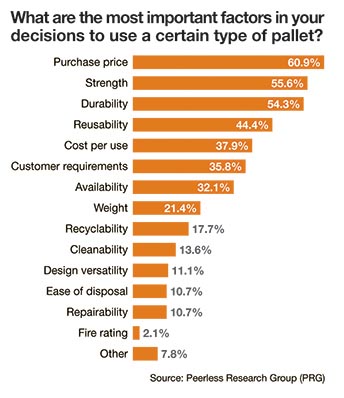
Wood pallets reign
Even as alternative materials make their way into the pallet landscape, wood continues to reign as the material of choice. When it comes to wood pallet usage, 46% of readers are using the same number of pallets that they were a year ago while 42% are using more. Just 12% are using fewer wood pallets than they were 12 months ago.
When asked about their experience obtaining wood pallets this year, 31% of readers say there are fewer pallets available and that used pallets are in short supply, but 35% say they haven’t experienced any issues in this regard. And, 27% complained that wood pallet quality is “not as good” or “worse,” and 18% say they’re paying higher prices for their pallets. Wood pallets, for example, have risen in cost by about 52%, according to the majority of respondents. 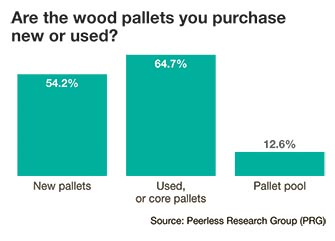
Comparing this year’s survey results to 2015 and 2014, respectively, more than 30% of respondents said there were fewer wood pallets available, up from 23%. And, 17% reported that used wood pallets were more expensive last year versus 2014.
Up-and-coming materials
Both plastic and metal are popular pallet material choices for certain types of companies and/or shipments. For 2016, about 73% of readers are using the same number of plastic pallets as they were the previous year while 13% are using fewer and another 13% are using more plastic pallets. In most cases, readers like the durability (57%), cleanliness/safety (43%) and sustainability (37%) associated with plastic pallets.
Looking ahead, 76% expect to maintain their approach to buying plastic pallets while 12% will increase their use of these pallets. Just 11% of readers will decrease their use of plastic. For 2015, 34% said they expected to use more plastic pallets during the next 12 months, up from 30% in 2014’s survey. While a majority of respondents last year said plastic pallet use would “stay the same” (57%) only 8% forecasted a decrease in their use.
Used to transport heavy goods for air freight and at-sea storage, metal pallets made from steel or aluminum may be a costlier choice, but remain a popular option for companies that use heavy payloads and that want pallets that are rackable, fireproof, and/or sanitary.
According to the survey, 89% of readers plan to maintain their current metal pallet usage approaches (versus 68% last year) while 11% will decrease their use of metal (versus 9% in 2015). Just 0.4% of respondents plan to acquire more metal pallets, and 0.8% plan to start using metal pallets for the first time in the next 12 months. About 99% of readers say they aren’t going to start using metal pallets during that time frame. 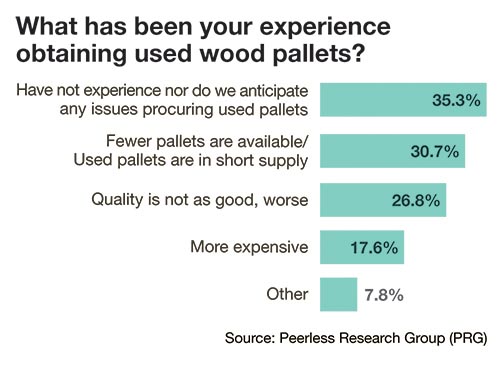
Answering the call
Customers may be becoming more demanding overall, but for the most part their pallet preferences aren’t changing too much. According to Modern’s readers, just 13% of customers have demanded changes in pallet usage over the last 12 months, with 87% saying they’ve fielded no such demands. Of those companies that have had to make changes, most (42%) are using more block pallets and 32% are using more stringer pallets. The types of businesses requiring those changes include manufacturers (37%), wholesalers (33%) and retailers (27%). 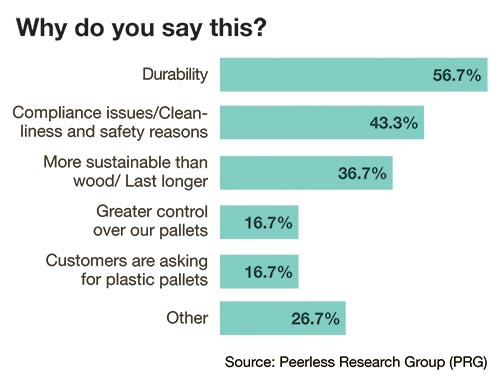
According to this year’s survey, just 7% of readers are using pallet rental companies and 7% are using some other type of pallet retrieval or recovery system. The majority of readers (46%) say they aren’t likely to use such a system over the next 12 months and 28% say this move is “not very likely.” Of those companies that are using pallet rental or management systems, 40% are using self-managed approaches while 34% rely on CHEP and 16% use PECO.
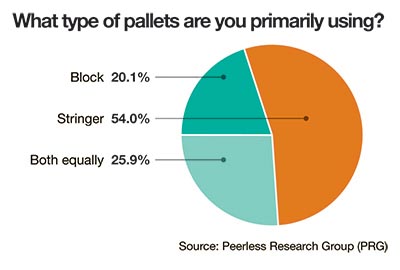
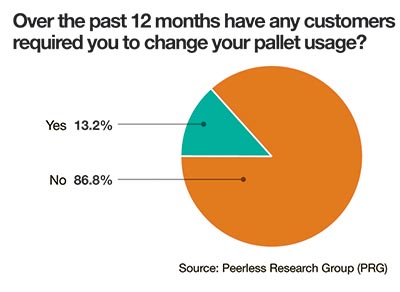
When asked if they’ve evaluated or considered a system or solution for creating or managing their own pallet pools, 24% of readers say “yes” and 76% say “no.” Just 8% says they’d want to hear more about pallet pooling service options and 40% say they wouldn’t be interested at all. 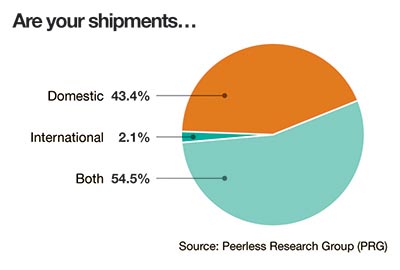
What customers want
Shipping primarily to national retailers like Walmart and Costco, and major supermarket chains like Publix and Safeway, respondents to this year’s reader survey ship domestically (43%), internationally (2%) and a mix of both (55%). Outside of the United States, the most popular shipping destinations include Canada (82%), Mexico/South America/Caribbean (74%) and China/Japan/SE Asia (58%).
For international shipments, readers say they take steps such as having their pallets treated (49%), using wood pallets that they own themselves (19%), and using plastic, corrugated, pressed wood or metal pallets rather than wood (19%). And, 16% of companies say their pallet usage strategy doesn’t change when shipping overseas.
Over the past two years, readers say the number of pallets they’ve been shipping internationally has remained the same (53%) or increased (38%). Over the next two years, an equal number of readers (48%) expect the number of international pallet shipments to either increase or remain constant.
New trends in pallets
For the 2016 reader survey, Modern also asked readers to give their thoughts on some new pallet trends, including an anticipated preference shift from stringer pallets to block pallets on the part of retailers. When asked about this possible shift, 45% of readers say they haven’t made any changes in that direction and 5% say they have. Another 26% say they’ve “unsure what they’ll do” about a move over to block pallets. Of those firms that are making the move, 56% say block pallets are more durable while 44% say they’re easier to load/unload and that they save time.
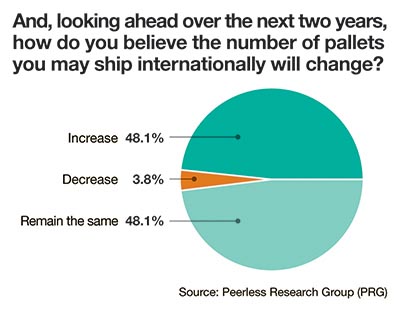
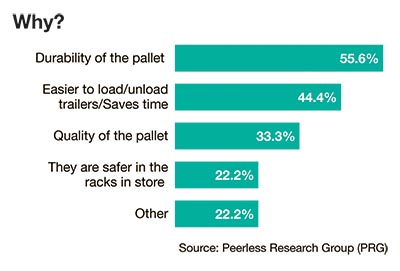
When asked if they will use a pallet leasing or a pooling management provider to obtain block pallets—should the shift from stringer pallets take place—50% of readers say they will and another 50% will not.
For now, just 9% of respondents are using (or, have used in the past) a third-party service to help them better understand the pallet and transport packaging combination (i.e., stretch wrap, shrink wrap, or banding) that’s best suited to their operation. Ninety-two percent of firms say they haven’t taken this route and 43% aren’t at all interested in it.

Article Topics
Latest in Logistics
Key benefits of being an Amazon Business customer with Business Prime USPS cites continued progress in fiscal second quarter earnings despite recording another net loss U.S. rail carload and intermodal volumes are mixed, for week ending May 4, reports AAR New Ryder analysis takes a close look at obstacles in converting to electric vehicles Norfolk Southern shareholders sign off on 10 board of directors nominees Between a Rock and a Hard Place Inflation and economic worries are among top supply chain concerns for SMBs More LogisticsAbout the Author
Subscribe to Logistics Management Magazine

Find out what the world's most innovative companies are doing to improve productivity in their plants and distribution centers.
Start your FREE subscription today.
May 2024 Logistics Management

Latest Resources














